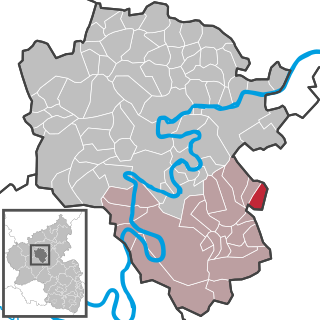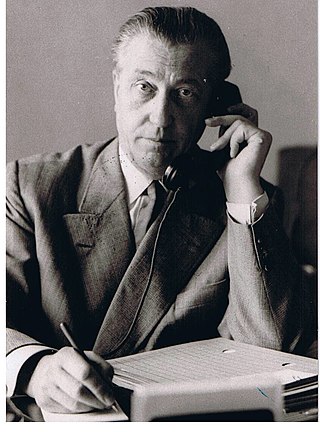
The Deutsche Mark, abbreviated "DM" or "D-Mark" ( ), was the official currency of West Germany from 1948 until 1990 and later the unified Germany from 1990 until the adoption of the euro in 2002. In English, it was typically called the "Deutschmark". One Deutsche Mark was divided into 100 pfennigs.

The Moselle is a river that rises in the Vosges mountains and flows through north-eastern France and Luxembourg to western Germany. It is a left bank tributary of the Rhine, which it joins at Koblenz. A small part of Belgium is in its basin as it includes the Sauer and the Our.
Mayen-Koblenz is a district (Kreis) in the north of Rhineland-Palatinate, Germany. Neighboring districts are Ahrweiler, Neuwied, Westerwaldkreis, district-free Koblenz, Rhein-Lahn, Rhein-Hunsrück, Cochem-Zell, and Vulkaneifel.

Cochem is the seat of and the biggest town in the Cochem-Zell district in Rhineland-Palatinate, Germany. With just over 5,000 inhabitants, Cochem falls just behind Kusel, in the Kusel district, as Germany's second smallest district seat. Since 7 June 2009, it has belonged to the Verbandsgemeinde of Cochem.

Traben-Trarbach on the Middle Moselle is a town in the Bernkastel-Wittlich district in Rhineland-Palatinate, Germany. It is the seat of the like-named Verbandsgemeinde and a state-recognized climatic spa (Luftkurort). The city lies in the so-called "Valley of Dawn".

Lahr in the Hunsrück is an Ortsgemeinde – a municipality belonging to a Verbandsgemeinde, a kind of collective municipality – in the Rhein-Hunsrück-Kreis district in Rhineland-Palatinate, Germany. It belongs to the Verbandsgemeinde of Kastellaun.

Bullay is an Ortsgemeinde – a municipality belonging to a Verbandsgemeinde, a kind of collective municipality – in the Cochem-Zell district in Rhineland-Palatinate, Germany. It belongs to the Verbandsgemeinde of Zell, whose seat is in the municipality of Zell an der Mosel.

Hesweiler is an Ortsgemeinde – a municipality belonging to a Verbandsgemeinde, a kind of collective municipality – in the Cochem-Zell district in Rhineland-Palatinate, Germany. It belongs to the Verbandsgemeinde of Zell, whose seat is in the municipality of Zell an der Mosel.

Moritzheim is an Ortsgemeinde – a municipality belonging to a Verbandsgemeinde, a kind of collective municipality – in the Cochem-Zell district in Rhineland-Palatinate, Germany. It belongs to the Verbandsgemeinde of Zell, whose seat is in the municipality of Zell an der Mosel.

Neef is an Ortsgemeinde – a municipality belonging to a Verbandsgemeinde, a kind of collective municipality—in the Cochem-Zell district in Rhineland-Palatinate, Germany. It belongs to the Verbandsgemeinde of Zell, whose seat is in the municipality of Zell an der Mosel. Neef is a winegrowing centre.

Peterswald-Löffelscheid is an Ortsgemeinde – a municipality belonging to a Verbandsgemeinde, a kind of collective municipality – in the Cochem-Zell district in Rhineland-Palatinate, Germany. It belongs to the Verbandsgemeinde of Zell, whose seat is in the municipality of Zell an der Mosel.

Sosberg is an Ortsgemeinde – a municipality belonging to a Verbandsgemeinde, a kind of collective municipality – in the Cochem-Zell district in Rhineland-Palatinate, Germany. It belongs to the Verbandsgemeinde of Zell, whose seat is in the municipality of Zell an der Mosel.

Tellig is an Ortsgemeinde – a municipality belonging to a Verbandsgemeinde, a kind of collective municipality – in the Cochem-Zell district in Rhineland-Palatinate, Germany. It belongs to the Verbandsgemeinde of Zell, whose seat is in the municipality of Zell an der Mosel.

Valwig is an Ortsgemeinde – a municipality belonging to a Verbandsgemeinde, a kind of collective municipality – in the Cochem-Zell district in Rhineland-Palatinate, Germany. It belongs to the Verbandsgemeinde of Cochem, whose seat is in the like-named town. Valwig is also a winegrowing centre.

Walhausen is an Ortsgemeinde – a municipality belonging to a Verbandsgemeinde, a kind of collective municipality – in the Cochem-Zell district in Rhineland-Palatinate, Germany. It belongs to the Verbandsgemeinde of Zell, whose seat is in the municipality of Zell an der Mosel.

The Koblenz–Trier Railway is a railway line in the German state of Rhineland-Palatinate, located mostly on the left (northern) bank of the Moselle, connecting Koblenz via Bullay to Trier. It is known in German as the Moselstrecke, i.e. "Moselle line". It is often called the Moselbahn links der Mosel to distinguish it from the Moselle Railway (Moselbahn) or Moselle Valley Railway (Moseltalbahn), which ran on the right (southern) bank of the Moselle from Bullay to Trier, but was abandoned in the 1960s. The line was built as part of the Cannons Railway (Kanonenbahn) and opened in 1879.

The Deutsche Staatsphilharmonie Rheinland-Pfalz is a German orchestra based in the German state of Rhineland-Palatinate, in Ludwigshafen am Rhein.. as of the 2015/2016 season.

The Lower Moselle is the name given to the lower reaches of the Moselle river - just under 100 kilometres long - in Germany between Pünderich and the Moselle's confluence with the Rhine at Koblenz. The Lower Moselle landscape differs from that of the Middle and Upper Moselle, much of it forming a narrower valley with high and steep sides in places. On the cut banks of the river that are oriented towards the south and west, vineyards are managed, often on the tiniest, terraced strips of land on steep hillslopes.

Vlexx GmbH is a rail transport company based in Mainz, Rhineland-Palatinate, Germany and a subsidiary of the Regentalbahn, which in turn has been part of the Italian state railway Ferrovie dello Stato (FS) since 2011 via its parent company Netinera. Vlexx operates local rail passenger transport exclusively with diesel railcars in Rhineland-Palatinate, Saarland and Hesse as well as a connection to France on the Winden-Wissembourg railway line into the Alsace to the railway station of Wissembourg.

Wilhelm Nowack was a German economist who became a journalist and, more briefly, a radio producer. He was also politically engaged. A committed believer in democracy and supporter of the German republic, in 1924 he was a co-founder of the Reichsbanner Schwarz-Rot-Gold movement. Much later, between 1949 and 1952, he served as a member of the ”Bundestag”, based at that time in Bonn. In 1951 he accepted an appointment as State Minister for Finance and Reconstruction for Rhineland-Palatinate, and just over a year later he resigned his seat in the Bundestag.




















